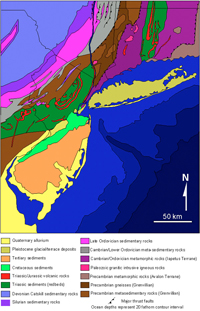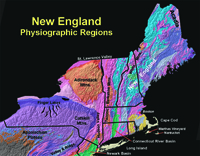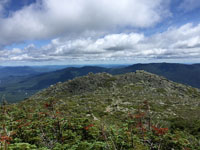
Regional Geology of North America |
|
Northern Appalachians (New England Province) |
Click on images for a
larger view. |
The New York City metropolitan region, home to nearly 25 million people, is uniquely located at the intersection of several physiographic provinces.
Southern New Jersey is part of the Coastal Plain Province (Figure 41). Long Island is formed from the terminal glacial moraines of the Late Pleistocene (Wisconsinian) continental glaciers that overly buried coastal plain deposits. The Highlands of northern New Jersey and Connecticut, and the island of Manhattan are metamorphic rocks that geologically part of the New England Province (and similar to the Piedmont except the region was glaciated). East of the Hudson River the bedrock consistsof Triassic to Early Jurassic sediments and volcanic rocks of the Newark Basin (a Mesozoic Basin). Nearby in northern New Jersey Highlands and along the Hudson Valley are folded and thrust-faulted sedimentary rocks of early Paleozoic Age (Valley and Ridge Province), and flat-lying sedimentary rocks of the Catskills and Pocono Mountains (New York and Pennsylvania) are part of the Appalachian Plateau Province.
The New England Province shares many of the same physiographic characteristics of the Piedmont and Blue Ridge (Figure 42). The province also share a similar complex geologic history with mountain building episodes associated with the Taconic, Acadian, and Allegheny orogenies (see Figure 37). One significant difference is that the entire region was covered by the Laurentide continental glaciers repeatedly throughout the Pleistocene Epoch. The White Mountains of Vermont and New Hampshire share a similarity with the Blue Ridge Province, both consisting of Grenvillian granitic metamorphic rocks of Precambrian Age (Figure 43).
Mt. Washington, elevation 6,288 feet (1,917 m) is the highest mountain in New England, and is famous for having the highest wind-gusts records for the world for many decades. Mt. Washington is one of the high peaks of the Presidential Range, a series of peaks named after American presidents. The Taconic Mountains are a fold-thrust belt (similar to the Valley and Ridge region) that runs north-to-south along east side of the Hudson River Valley. The Hudson River itself is a fjord, a submerged glaciated river valley.
Both Long Island and Cape Cod, and the islands of Marthas Vineyard and Nantucket consist of surficial deposits of glacial moraines and outwash deposited by continental glaciers (Figure 45).
|
 |
| Fig. 41. Geologic map of the New York City region, a region that encompasses parts of several provinces in relatively close proximity Learn more at Geology of the New York City Region (USGS website). |
 |
 |
 |
 |
| Fig. 42. The New England Province consists of many elements similar to the Piedmont and Blue Ridge Provinces, except that the region was covered by continental glaciers. |
Fig. 43. View of the Presidential Range in the White Mountains region of New Hampshire and Vermont as seen from this view along the Appalachian Trail. |
Fig. 44. The Connecticut River flows south through a Mesozoic basin that bisects older rocks of the Connecticut Highlands of the New England Province (Northern Appalachians). |
Fig. 45. Cape Cod, a hook-shaped peninsula in Massachusetts, with Martha's Vineyard (island below and left) formed from (and reworked from) Pleistocene glacial deposits. |
|
| https://gotbooks.miracosta.edu/geology/regions/new_england.html 1/20/2017 |

|
 |
|
|





